Saint Martin’s in the Cornmarket might sound like somewhere in a Thomas Hardy novel. In fact it is a busy place, situated in central Worcester. This is a city with a rich history, reflected in the many fascinating streets in the Cornmarket which contain some very old buildings. St Martin’s is a Georgian church built in the 1770s, designed by the architect Anthony Keck. Some compare it internally to a smaller version of Saint Martin-in-the-Fields in London. For over 100 years the church has maintained a Catholic tradition, and still does so today.
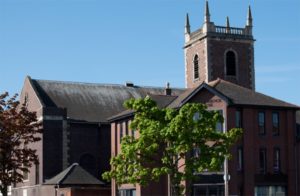 There are two churches dedicated to St. Martin of Tours in Worcester, and ours is often known as ‘Old St Martin’s’, to distinguish it from the church built in London Road in the early 1900s, and which was originally intended to replace ‘Old’ St Martin’s.
There are two churches dedicated to St. Martin of Tours in Worcester, and ours is often known as ‘Old St Martin’s’, to distinguish it from the church built in London Road in the early 1900s, and which was originally intended to replace ‘Old’ St Martin’s.
The present building is not old as far as churches go, having been consecrated, after rebuilding on the same site as earlier churches, in 1772. It replaced a building which was largely 14th century, with later additions. There is believed to have been an even older, 11th century, church before that.
The 14th century church was a strange looking building; it had three gabled east windows and three gabled windows on the south side. It had a tower, and a timber-framed south porch with a room above. It is possible that William Shakespeare was married to Ann Hathaway in this building in 1582; it is known that they came to Worcester to obtain a licence for their marriage, and St. Martin’s was on the road out of the city which they would have used. Part of the mystery is that what would have been the relevant page in the church’s marriage register has been torn out.
In 1767 the old church was demolished, and replaced by the present building. Although Anthony Keck, of Gloucester, is generally credited with designing St. Martin’s, there is evidence that a Henry Keene was also involved. The rebuilding took four years, and cost £2,215. The tower was completed later, in 1780.
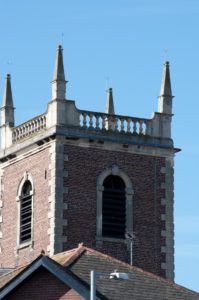
The church tower houses bells recently installed to help train ringers of the future.
The west gallery was erected in 1811 and side galleries (now removed) in 1830. The organ (not the present one) was originally in the north-east of the church. In the mid-Victorian period, the east window was replaced by the present Gothic window, which does not, perhaps, sit very happily with the generally classical architecture of the building.

Main entrance to the church with new gates.
Around the turn of the 19th/20th centuries further alterations were made as a result of the influence of the Oxford movement, and since that time the church and its worship have reflected the Anglo-Catholic tradition within the Church of England.
Old St Martin’s Parish
The Church stands in what was once the commercial hub of the city. The Cornmarket, Mealcheapen Street, New Street and Queen Street were a densely populated and closely knit community of family-business and work people. The parish boundaries also included the Lowesmoor area, now the scene of a major commercial development*. In 1905, Old St. Martin’s became a Chapel-of-Ease to St Swithun’s, a near-by city centre church. St Swithun’s was declared redundant in 1977, and in the 1980’s, St. Paul’s-in-the-Blockhouse, where Geoffrey Studdert Kennedy (‘Woodbine Willie’) had been the incumbent from 1914-21, was closed for Anglican worship, so that St. Martin’s parish now embraces the areas originally covered by St. Swithun’s and St. Paul’s. The parish therefore extends as far as Shrub Hill Railway Station to the east. The parish was legally part of the ‘Worcester City Parish’, which comprised the three parishes of Old St Martin’s, All Saints and St George’s Barbourne; but in 2015 this arrangement was changed and St. Martin in the Cornmarket was separated into the Benefice of St. Martin the in the Cornmarket with St. Swithun and St. Paul.
* because of the Church’s geographical position in what the developers have called ‘St Martin’s Quarter’, and on the east-west axis from Lowesmoor to the City Centre, the Parochial Church Council are currently implementing a major plan to improve the Church, the Churchyard and the nearby Parish Room for both Church and Community use.
Points of interest in the Church
The Church has a quite remarkable interior, with a vaulted ceiling which springs from square blocks of Ionic entablature supported by splendid and graceful columns. The whole creates a spacious effect and avoids the separation of nave and aisles which occurs with more usual lintel and column arrangement.
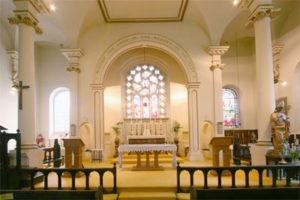
Around the walls are the fourteen Stations of the Cross, which were installed as a memorial to Fr William Monahan, Rector of St. Swithun’s with Old St. Martin’s from 1902-1948. The visitor will also notice a large number of brass memorial plates fixed to the dark oak panelling. These refer to some of the many interments which took place in the vaults below, and bear the names of prominent families and business people who once lived in the parish.
There are several statues; the largest is a representation of St. Martin of Tours. Near the entrance porch is Our Lady with the Holy Child, and in the Lady Chapel on the south side Our Lady of Walsingham and St. Joseph. On the north side is a large Calvary, and a statue of St. Patrick. The Chapel on the north side is dedicated to the Sacred Heart of Jesus (the Divine Compassion).
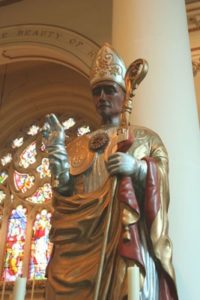
St. Martin of Tours
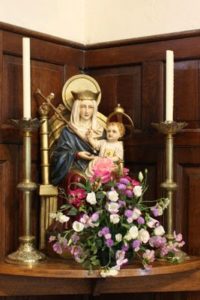
Old Lady with the Holy Child
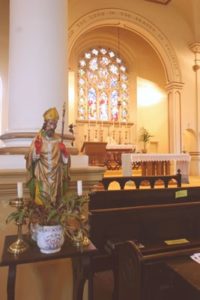
St. Patrick
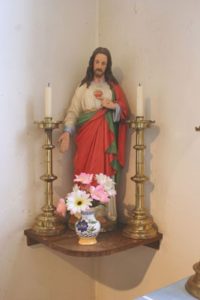
Sacred Heart of Jesus
The stained glass, mostly Victorian, shows, on the north side, above the Calvary, John the Baptist, then moving eastwards, the Raising of Lazarus and the Resurrect- ion of Jesus; in the east wall of the Lady Chapel, the Trans figuration and on the south side ‘suffer little children’ and to the west of the porch door the walking on the water.
The roundels above the gallery depict the Nativity and the Epiphany. The Organ is situated in the gallery; it was moved there at the time of the re-ordering of the chancel in 1987. The Altar Crucifix and Candlesticks on the High Altar are French and were the gift of Canon Wylde, Rector from 1891-7; those on the Sacred Heart Altar are from St Paul-in the Blockhouse, and are in memory of the men of that parish who lost their lives in the 2nd World War.
Other items of interest (not displayed)
The Church possesses a fine collection of vestments, including a heavily embroidered dark red High Mass set which belonged to Fr. Monahan. They were re-made from Belgian silk by monks of Caldey Island. There is also a red Cope which was dedicated by Fr. Studdert Kennedy on his arrival in St. Paul’s parish in 1914; there are photographs of him wearing it.
The Church Plate includes a large silver paten, dated 1869, an alms dish of 1638 and a flagon dated 1813.
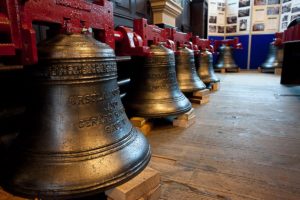
Full-circle ringing of the original six bells in the Tower is not possible, but they now provide quarter chimes. One of them was cast about 1320 and is dedicated to St. Martin, its inscription being SANCTE MARTINE ORA PRO NOBIS. It is one of the oldest bells in the diocese. Three bells were cast by Hugh Watts of Leicester, 1638-40. Other bells are by Thomas Mears of London (1833) and Thomas Rudhall of Gloucester (1780). The Sanctus Bell is dated 1621. In 2011, a new ring of ten bells, cast by Taylor’s of Loughborough, was installed in the tower below the original bells. These are used as part of the Cathedral’s training programme for young bell-ringers.

